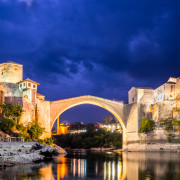Easy Lightroom Workflow for Landscape Photography
When you start your journey in landscape photography, you quickly realize that your in-field work is only 50% of the process. There’s only so much detail that you can put into a RAW file using your camera. The next hurdle you face is to master post processing workflow in Lightroom. Post processing can be intimidating. However, when you figure out how to use Lightroom’s RAW converter, the work becomes exciting. In this article, I’ll show you three important steps to master Lightroom post processing and create amazing landscape photos.
When you take a landscape photo, there are reasons that you pressed the shutter. There was either great light or an outstanding photography composition. The goal of Lightroom workflow is not to alter that photo into something unrealistic (although there is nothing wrong with it). Instead, the goal of Lightroom workflow is to enhance the things that made you take the photo in the first place.
To show you the steps I’m going through, we’ll be referring back to a photograph that I shot in Great Smoky Mountains National Park. I wanted to photograph this scene because of the atmospheric fog around the sun. I also wanted to build a contrast between the silhouette of the tree and the rising sun. Lastly, I had never seen an orange glow like this at Clingman’s Dome in the Smokies, so I wanted to capture the unique light. However, there is clearly a lot that needs to be adjusted in this photograph.
Step #1: Analyze your Landscape Photo
The first step to master post processing for landscape photography is image analyze. This is perhaps the most important and least understood step in post processing. However mastering this step will guide rest of your post processing workflow. Analyzing your landscape photo requires you to take some time and determine exactly what adjustment are needed. Knowing this you will be able to avoid playing with sliders and hoping for the best.
I told you why I took the photograph, now it’s time to analyze what needs to be adjusted. Remember, the goal is to enhance the photo to compliment the reasons why you took the photo. Take a moment to inspect the photograph and find what you’d like to adjust. For me, I want to crop this photo vertically to compliment the subject matter. I’d also like to enhance the shadows and highlights around the sun. Lastly, we can also clean up the dust spots in the photograph in post-processing to make it a clean image.
Now that I’ve analyzed the photograph, I have a plan in place as to what to adjust. This will allow me to strategically maneuver through Lightroom post processing with a purpose.
Step #2: Make Global Adjustments in Lightroom
A global adjustment is an edit that will alter the entire photograph. Global adjustments include your exposure slider, contrast, highlights, and shadows, just to name a few. These adjustments will impact every pixel within your photograph, so be sure to watch how it’s making adjustments.
I can crop the image vertically since that will globally impact my photograph. After that, I’m going to adjust my contrast, highlights, shadows, and my vibrance and saturation. All of these edits create more detail in my photograph while enhancing my in-field vision. These global adjustments look good, but there’s still work to be done. Once you finish global adjustments, you can move on to edits that will impact smaller areas of the photo.
Step #3: Make Local Adjustments in Lightroom
Local adjustments are edits that fine-tune your photograph. They are the last steps that may seem small, but they can have a big impact. Local adjustments can make colors pop as well as make subtle details come to life. Without local adjustments, a photograph can fall flat. However, photographs jump off the page with local adjustments.
In this photograph specifically, I’m going to use my adjustment brush to enhance the clouds around the sun more. It may be a subtle change, but it’s necessary. I’m also going to work locally to remove dust spots on my lens. Lastly, I made slight adjustments to the orange and yellow tones as well as darkened the corners of the photograph. Using subtle adjustments will make your photos more dramatic. Other local adjustments can include gradient filters, radial filters, and dodging and burning techniques.
Here is another example from my recent Lightroom for Landscape Photography Tutorial where I used these these 3 important post processing steps to achieve spectacular results.
Without a plan in post-processing, you can feel lost in the multitude of sliders and tools. It can be difficult knowing which edit to specifically make. When you do have a plan in post-processing, your work because calculated and successful. Follow these three important steps to master post-processing today. By following these simple steps you will find that creating great landscape photography images with post-processing is easier than you thought.














